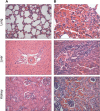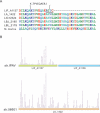Comparative proteogenomic analysis of the Leptospira interrogans virulence-attenuated strain IPAV against the pathogenic strain 56601
- PMID: 21423275
- PMCID: PMC3193473
- DOI: 10.1038/cr.2011.46
Comparative proteogenomic analysis of the Leptospira interrogans virulence-attenuated strain IPAV against the pathogenic strain 56601
Abstract
The virulence-attenuated Leptospira interrogans serovar Lai strain IPAV was derived by prolonged laboratory passage from a highly virulent ancestral strain isolated in China. We studied the genetic variations of IPAV that render it avirulent via comparative analysis against the pathogenic L. interrogans serovar Lai strain 56601. The complete genome sequence of the IPAV strain was determined and used to compare with, and then rectify and reannotate the genome sequence of strain 56601. Aside from their highly similar genomic structure and gene order, a total of 33 insertions, 53 deletions and 301 single-nucleotide variations (SNVs) were detected throughout the genome of IPAV directly affecting 101 genes, either in their 5' upstream region or within their coding region. Among them, the majority of the 44 functional genes are involved in signal transduction, stress response, transmembrane transport and nitrogen metabolism. Comparative proteomic analysis based on quantitative liquid chromatography (LC)-MS/MS data revealed that among 1 627 selected pairs of orthologs, 174 genes in the IPAV strain were upregulated, with enrichment mainly in classes of energy production and lipid metabolism. In contrast, 228 genes in strain 56601 were upregulated, with the majority enriched in the categories of protein translation and DNA replication/repair. The combination of genomic and proteomic approaches illustrated that altered expression or mutations in critical genes, such as those encoding a Ser/Thr kinase, carbon-starvation protein CstA, glutamine synthetase, GTP-binding protein BipA, ribonucleotide-diphosphate reductase and phosphate transporter, and alterations in the translational profile of lipoproteins or outer membrane proteins are likely to account for the virulence attenuation in strain IPAV.
Figures








Similar articles
-
Genetic diversity among major endemic strains of Leptospira interrogans in China.BMC Genomics. 2007 Jul 1;8:204. doi: 10.1186/1471-2164-8-204. BMC Genomics. 2007. PMID: 17603913 Free PMC article.
-
Identification of a novel prophage-like gene cluster actively expressed in both virulent and avirulent strains of Leptospira interrogans serovar Lai.Infect Immun. 2008 Jun;76(6):2411-9. doi: 10.1128/IAI.01730-07. Epub 2008 Mar 24. Infect Immun. 2008. PMID: 18362131 Free PMC article.
-
Comparative subproteome analysis of three representative Leptospira interrogans vaccine strains reveals cross-reactive antigens and novel virulence determinants.J Proteomics. 2015 Jan 1;112:27-37. doi: 10.1016/j.jprot.2014.08.015. Epub 2014 Sep 6. J Proteomics. 2015. PMID: 25201075
-
Comparative genomic analysis of eight Leptospira strains from Japan and the Philippines revealing the existence of four putative novel genomic islands/islets in L. interrogans serovar Lai strain 56601.Comp Immunol Microbiol Infect Dis. 2014 Dec;37(5-6):289-97. doi: 10.1016/j.cimid.2014.09.001. Epub 2014 Oct 5. Comp Immunol Microbiol Infect Dis. 2014. PMID: 25449997
-
Characterization of the cheY genes from Leptospira interrogans and their effects on the behavior of Escherichia coli.Biochem Biophys Res Commun. 2006 Jun 30;345(2):858-66. doi: 10.1016/j.bbrc.2006.04.159. Epub 2006 May 6. Biochem Biophys Res Commun. 2006. PMID: 16701553
Cited by
-
Diagnosis of canine leptospirosis by a highly sensitive FRET-PCR targeting the lig genes.PLoS One. 2014 Feb 24;9(2):e89507. doi: 10.1371/journal.pone.0089507. eCollection 2014. PLoS One. 2014. PMID: 24586833 Free PMC article.
-
Pathogenomic inference of virulence-associated genes in Leptospira interrogans.PLoS Negl Trop Dis. 2013 Oct 3;7(10):e2468. doi: 10.1371/journal.pntd.0002468. eCollection 2013. PLoS Negl Trop Dis. 2013. PMID: 24098822 Free PMC article.
-
A Novel Pan-Genome Reverse Vaccinology Approach Employing a Negative-Selection Strategy for Screening Surface-Exposed Antigens against leptospirosis.Front Microbiol. 2017 Mar 14;8:396. doi: 10.3389/fmicb.2017.00396. eCollection 2017. Front Microbiol. 2017. PMID: 28352257 Free PMC article.
-
Genomic Variability among Field Isolates and Laboratory-Adapted Strains of Leptospira borgpetersenii Serovar Hardjo.Int J Microbiol. 2018 May 22;2018:2137036. doi: 10.1155/2018/2137036. eCollection 2018. Int J Microbiol. 2018. PMID: 29951097 Free PMC article.
-
Reverse Vaccinology: An Approach for Identifying Leptospiral Vaccine Candidates.Int J Mol Sci. 2017 Jan 14;18(1):158. doi: 10.3390/ijms18010158. Int J Mol Sci. 2017. PMID: 28098813 Free PMC article. Review.
References
-
- Bharti AR, Nally JE, Ricaldi JN, et al. Leptospirosis: a zoonotic disease of global importance. Lancet Infect Dis. 2003;3:757–771. - PubMed
-
- Faine S, Adler B, Bolin C, Perolat P.Leptospira and LeptospirosisMelbourne: Medisci, 1999
Publication types
MeSH terms
Substances
LinkOut - more resources
Full Text Sources
Molecular Biology Databases
Research Materials

